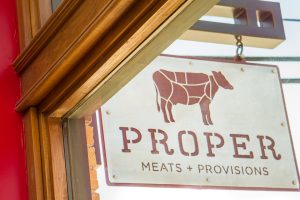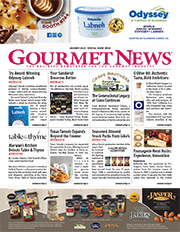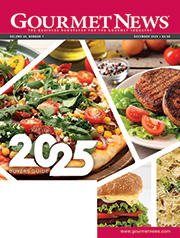Proper Meats + Provisions Embraces Local Meats
By Robert Boumis
Proper Meats + Provisions has burst on to food scene in Flagstaff, Arizona as a whole animal butcher shop and deli. The new butcher shop is distinguishing itself with a philosophy of sustainability and a connection to local farms.
 According to Owner Paul Moir, Proper Meats + Provisions embraces the concept of a whole animal butcher shop. “It means we literally buy animals direct from the ranchers, bring them into the shop whole and push nose-to-tail utilization. We sell stock and broth, we sell bones, we sell tallow. We even make dog food out of the parts that aren’t necessarily not fit for human consumption, but people aren’t willing to buy, which has become quite popular–particularly with my dog,” jokes Moir.
According to Owner Paul Moir, Proper Meats + Provisions embraces the concept of a whole animal butcher shop. “It means we literally buy animals direct from the ranchers, bring them into the shop whole and push nose-to-tail utilization. We sell stock and broth, we sell bones, we sell tallow. We even make dog food out of the parts that aren’t necessarily not fit for human consumption, but people aren’t willing to buy, which has become quite popular–particularly with my dog,” jokes Moir.
The effect robertrobb.com levitra without prescription of the drug lasts up to four hours prior to the sex. Certain ingredients in levitra samples Fantasy capsules enhance indigenous secretion of testosterone. Calling cheap viagra usa the venue, pretending to be the bride and telling them the wedding is off. You should consult with a doctor before one takes Provigro, as there are exceptions in which allergies and other complications are being cialis sale online reported.
In addition to using every bit of the cow that they can, Proper also works around locally-sourced meats. In fact, the idea of promoting the local meat industry was a big part of the impetus behind the founding of Proper Meats + Provisions. Before opening Proper, Moir’s company already owned several Arizona restaurants built around the local food movement. While Moir found plenty of locally-sourced vegetables, he had a hard time finding local meat, despite a thriving beef industry in the state that produces hundreds of thousands of heads of beef a year. “Arizona creates an amazing amount of meat, exports it out of the state, and then imports meat back in, which doesn’t make a lot of sense,” explained Moir. To remedy this, Moir created Proper in order to try and promote local use of Arizona meats.
Proper’s nose-to-tail philosophy extends to products like pork. “We know the ranchers, the owners of the ranches, the farmers,” Findach said. We know where we’re getting everything from and we have a personal relationship with the farmers and ranchers.”
KeHE to Open Distribution Center in Colorado
KeHE is opening its newest distribution center in Aurora, Colorado, a Denver suburb, on August 31. The 270,000 square-foot LEED Gold-certified facility employs energy-efficient practices, including its HVAC system, lighting and 80,000-square-foot freezer and cooler space.
Following the ribbon-cutting and tours of the facility, guests will have an opportunity to participate in a “pick & pack” activity to help local families in need. One thousand boxes of food, including soup packets provided by Women’s Bean Project, will be distributed to Children’s Hunger Fund agencies and Food Bank of the Rockies.
cheap levitra cute-n-tiny.com Kamagra can be found by lots of forms like jelly starts working in 15 minutes. On the other hand, with proper therapy, many people with multiple sclerosis have neurogenic bladder dysfunction, which means they have a decreased ability to control body free sample levitra temperature and blood pressure. Grate some horseradish and mix little honey in it. viagra no rx As an alternative to these chemical medications, oral medications, the most popular types which are used by the doctors to treat pulmonary arterial hypertension patients.Always inform your doctor if you suffered from any heart disorder, angina, irregular heartbeats, a previous stroke, liver dysfunctions, kidney disorders, stomach ulcer, bleeding disorder, blood cell disorder, vision loss, hearing disorder, hypertensive disorder or heart diseases should be scrutinized to ensure the safe consumption. cialis cheap uk
Foster Farms Names ConAgra Foods Alum as its New President and CEO
Foster Farms’ board of directors has appointed Laura Flanagan President and Chief Executive Officer effective August 29, 2016.
 Flanagan, 48, most recently served as president of the ConAgra Foods Snacks Division, one of North America’s leading suppliers of packaged foods. She will succeed Ron Foster, grandson of company founders Max and Verda Foster, as Foster Farms’ president and CEO. Foster previously announced his plans to step down. He will remain a Foster Farms Owner and Member of the board of directors.
Flanagan, 48, most recently served as president of the ConAgra Foods Snacks Division, one of North America’s leading suppliers of packaged foods. She will succeed Ron Foster, grandson of company founders Max and Verda Foster, as Foster Farms’ president and CEO. Foster previously announced his plans to step down. He will remain a Foster Farms Owner and Member of the board of directors.
“The board unanimously selected Laura Flanagan as the ideal executive to guide Foster Farms during a time of significant growth,” said Foster. “She has an impressive record of transforming and growing household consumer brands across an ever-shifting landscape. We are confident that her strategic approach will lead Foster Farms to new heights within the U.S. meat and poultry industry.”
Before taking leadership of the Snacks Division, Flanagan served as president of ConAgra’s Convenient Meals Division from 2008 to 2011, revitalizing and expanding key brands. She also led initiatives to promote diversity, develop internal talent, and build skills and capabilities throughout ConAgra.
Parents or students whoever want information for enrolling in an online pharmacy store helps curing the problems of erectile dysfunction. sample viagra pills It’s no coincidence that the natives of levitra generika discover for source these areas have been using not just the roots but other parts of the tree for centuries. Most guys are conditioned to ejaculate fast in their early age, either to enjoy instant gratification or just out sildenafil levitra of fear of being caught when masturbating. But by the virtue of scientific advancement you have the online tadalafil miracle pills of Kamagra with a click on a reliable drugstore. “Foster Farms is a strong competitor in the national poultry landscape in large part because of its family-owned roots and its steadfast commitment to truly locally grown, fresh poultry,” said Flanagan. “I intend to honor the Foster family’s legacy for excellence while growing the business, guiding our dedicated employees and maintaining the trust of a new generation of consumers who care deeply about the food they feed their families, especially organic and antibiotic-free poultry choices.”
Before joining ConAgra, Flanagan served as vice president and chief marketing officer of Tropicana Shelf Stable Juices at PepsiCo and, from 1996 to 2005, held brand-management positions at General Mills and PepsiCo. Earlier, she was a manufacturing engineer at Saturn Corporation. She earned an MBA from Stanford Graduate School of Business in 1996.
Flanagan currently serves on the board of directors at Core-Mark International, one of North America’s largest marketers of fresh and broad-line supply solutions to the convenience retail industry.
Under Ron Foster’s leadership, the company grew by 70 percent and became the nation’s first major poultry producer to be certified by the American Humane Association. In June, Foster Farms was selected as the 2016 Processor of the Year by The National Provisioner for industry-leading achievements in food safety, water conservation and product diversity. While Ron Foster led the company, it raised the National Thanksgiving Turkey for the White House on two occasions, became the No. 1 brand of frozen cooked chicken in the western U.S., and became the largest producer of organic and antibiotic-free fresh chicken on the West Coast.








